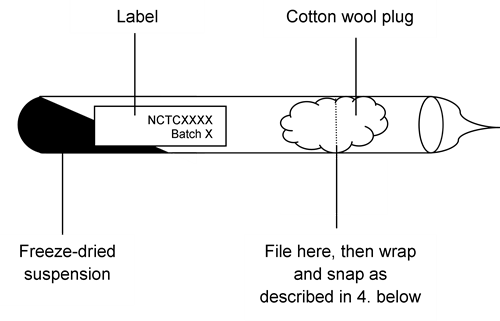How to handle bacteria and fungi on receipt
A guide for opening NCTC and NCPF glass ampoules and reconstitution of freeze-dried material.
View a photo guide of the instructions or watch a video
Refer to the Material Safety Data Sheet and the Certificate of Analysis for more specific details about your individual products you have purchased.


1. On receipt store the ampoules between 4°C ± 10°C
2. Safety Recommendation: Ampoules of HAZARDOUS PATHOGENS should be opened under appropriate Advisory Committee on Dangerous Pathogens containment level, and in an exhaust protective cabinet, designed to protect the worker against inhalation of aerosols (in the UK, a Class I or Class III cabinet. (see Conditions of supply of microbial pathogens: Safety)
3. Identify the culture by the number on the paper inside or outside the ampoule, reading from the round end of the tube. Care should be taken in opening the ampoule as the contents are in a vacuum
4. For opening ampoules by snapping:
-
gently clean the outside of the glass ampoule using a suitable disinfectant. Using a diamond cutter, diamond pen or glass file, make a deep score around the circumference of the ampoule in the centre of the cotton wool plug
-
wrap the ampoule in a disinfectant wipe. In addition, wrap some paper towel around the outside of this to secure a suitable protection layer to prevent penetration of glass when the ampoule is snapped. Ensure that gloves and safety glasses along with a laboratory coat are worn, and that you are working within the safety cabinet
-
snap the ampoule whilst wrapped where the score mark was made
-
carefully unwrap the ampoule, taking care as fragments of glass may be present in the tissue, and discard the tissue along with the ampoule tip into a sharps bin
-
when the ampoule is cracked air will enter, filtered by the plug. The plug may be impregnated with dried culture and should be discarded. Do not handle the plug directly; if this separates from the ampoule tip, remove with forceps
-
proceed to step 6 below and follow the instructions for reconstituting the ampoule contents
5. For opening ampoules using a heat source:
-
gently clean the outside of the glass ampoule using a suitable disinfectant. Using a diamond cutter, diamond pen or glass file, make a deep score around the circumference of the ampoule in the centre of the cotton wool plug
-
heat a thin glass rod or pipette capillary until the tip is red hot and molten, then quickly and firmly apply the heated end to the score mark to crack the ampoule. If only a short crack is produced, tap gently at this point to complete the encirclement
-
if the initial attempt to crack the ampoule is unsuccessful, repeat using a fresh piece of heated glass; the molten tip diameter should not be more than 2-3mm. If the ampoule still fails to crack, leave it to cool for a few minutes. Check the score mark and, if necessary, re-score to produce a deeper and longer mark. Ensure that the glass rod/capillary used is adequately heated and that it is applied quickly to the score mark before it cools
-
when the ampoule is cracked air will enter, filtered by the plug. The plug may be impregnated with dried culture and should be discarded. Do not handle the plug directly; if this separates from the ampoule tip, remove with forceps
-
proceed to step 6 below and follow the instructions for reconstituting the ampoule contents
6. Reconstitution:
-
using a pasteur pastette, add approximately 0.5ml of broth, when necessary enriched with blood, to the ampoule and leave the contents to rehydrate for 5-10 minutes. Mix the contents carefully to avoid frothing or creating aerosols
-
according to the gaseous and growth requirements, the broth suspension should be sub-cultured on to a suitable medium or media, preferably chosen to include a solid medium, both to obtain single colonies and to detect aerial contaminants which may be introduced during the opening of the ampoule.
-
routinely, one drop/loop of suspension is sufficient to achieve the required level of growth. However, for fastidious strains, the broth suspension should be sub-cultured by putting more than 3 drops (75 – 150 µl) on to a suitable medium or media.
-
discard the used ampoule into sharps bin.
